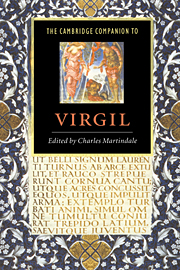Book contents
- Frontmatter
- Contents
- List of illustrations
- List of contributors
- Preface
- 1 Introduction: ‘The classic of all Europe’
- Part 1 Translation and reception
- 2 Virgil in English translation
- 3 Modern receptions and their interpretative implications
- 4 Aspects of Virgil's reception in antiquity
- 5 The Virgil commentary of Servius
- 6 Virgils, from Dante to Milton
- 7 Virgil in art
- Part 2 Genre and poetic career
- Part 3 Contexts of production
- Part 4 Contents and forms
- Dateline compiled by Genevieve Liveley
- List of works cited
- Index
- Plates
7 - Virgil in art
from Part 1 - Translation and reception
Published online by Cambridge University Press: 28 May 2006
- Frontmatter
- Contents
- List of illustrations
- List of contributors
- Preface
- 1 Introduction: ‘The classic of all Europe’
- Part 1 Translation and reception
- 2 Virgil in English translation
- 3 Modern receptions and their interpretative implications
- 4 Aspects of Virgil's reception in antiquity
- 5 The Virgil commentary of Servius
- 6 Virgils, from Dante to Milton
- 7 Virgil in art
- Part 2 Genre and poetic career
- Part 3 Contexts of production
- Part 4 Contents and forms
- Dateline compiled by Genevieve Liveley
- List of works cited
- Index
- Plates
Summary
Of all the classical authors it is Virgil whose visual legacy is the most difficult to define. With most other writers, artists were mainly concerned with illustrating their works, though the choice of subject represented and its interpretation or intended reading by the viewer may be inflected by the time and context in which it occurs. So, for example, while allegorical meanings were sometimes imparted to otherwise literally rendered episodes from writers like Homer and Ovid, or some historical event described by Plutarch or Livy could be used to express an ideal of exemplary action or to point a moral, on the whole the iconographies associated with particular authors predominantly fall into the category of illustration. Virgil is different because his influence on artists is so varied in its content and interpretation.
There are, of course, a great many works of art which individually or in series draw their subjects directly from what he wrote and which very accurately reproduce his words - indeed, only Ovid has been more frequently or more exhaustively illustrated - but Virgil's presence in art goes much further than the process of translating texts into images.
- Type
- Chapter
- Information
- The Cambridge Companion to Virgil , pp. 91 - 104Publisher: Cambridge University PressPrint publication year: 1997
- 7
- Cited by

